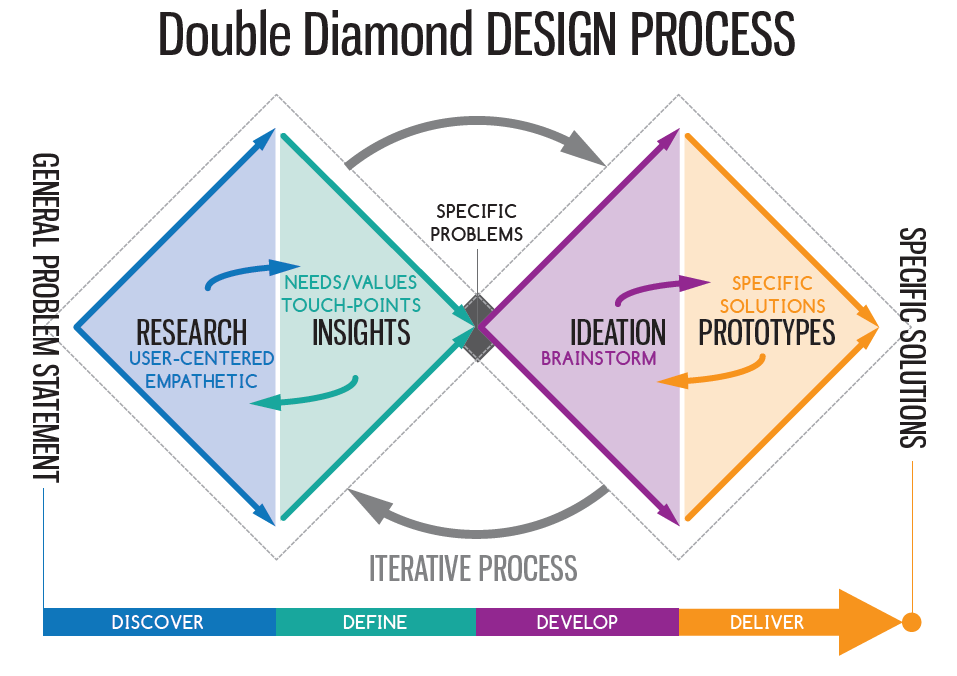To lift a first tip of the veil around Design Thinking, it is only right to quote Tim Brown (the current CEO of IDEO). While still under the direction of co-founder David Kelley, IDEO was one of the founding fathers of the application of Design Thinking in the industry. Two striking examples of the final product of Design Thinking at IDEO are the first Apple mouse and the Palm V PDA; two innovative products with a major impact on the industry.
“Design thinking is a human-centred approach to innovation that draws from the designer's toolkit to integrate the needs of people, the possibilities of technology, and the requirements for business success.” Tim Brown, CEO of IDEO
Design thinking is based on a few key principles
- Human-centred: On the one hand, Design Thinking puts the emphasis on a good customer experience (of the service or the product), while the human aspect of the participants of a Design Thinking process is also central on the other.
- Designer’s toolkit: Design Thinking was originally used to develop (end) products, while also being used for the 'design' of a service (Service Design Thinking) or solving problems nowadays.
- Needs of people: Design Thinking tries to find a solution that responds to needs (desirability), that is within the possibilities of the technology (feasibility) and that is viable (viability).
Design thinking is still in full development; you can therefore find a variety of models with a spectrum of steps: 3, 4, 5, 6 or 8. Stanwick relies on the model (see above) with 4 steps placed in two diamonds ("double diamond", Service Design Vancouver – link).

You begin with a general problem statement (on the left). You start with the 'Research' phase, where you try to acquire information about the problem through qualitative and quantitative research, with a focus on your customer. At that point, you pull the problem open again (see opening arrows). With the information you have acquired, you step into the 'Insights' phase, where you try to link together all the information in order to gain insights into the needs and values of the customer. This will ensure that you will converge (see arrows that come together) towards a clear view of the specific problems (middle). After the alignment of the team, the moment for the 'Ideation' phase has come. This means: the time to bring out the craziest ideas and to encourage each other to do this in order to open up the spectrum of solutions (see opening arrows). These crazy inspirations take on the role of seeds for the ultimate, practically usable ideas (= shoots) in the 'Prototypes' phase. You want to nourish these shoots on the one hand (do not trample on them!), but to also transplant them in the natural habitat on the other. You do this by making a prototype of a few ideas and confronting your customer with it, according to the slogan "Fail fast but fail cheap". This will eventually end with specific solutions (right).
In turn, there are different variations of the "double diamond" model. All models have their own value, but we prefer the above model (Service Design Vancouver). First and above all, the number of steps is limited (4) and they are clearly displayed. The backward and forward arrows show that this is an iterative process; from diamond 1 to diamond 2, as well as inside the diamonds. This representation also strongly relates to reality, in which you will never be able to work your way to the solution in one straight line (e.g. in 6-Sigma, you will also never follow the letters D-M-A-I-C in one direction). Furthermore, this model will force you to look at your customer in two of the four phases: a) Research: "user-centred" indicates qualitative research into your customer (e.g. VOC, interviews, following your customer) and b) Prototypes: "specific solutions" (confronting customers with prototypes). Finally, it shows very visually that you first open up the problem through your 'Research', in order to then end up with a specific problem with your 'Insights'. With the 'Ideation', you will open up the spectrum of solutions in order to then again end up with specific solutions based on 'Prototypes'.
Why Design Thinking?
- To connect Creativity with Innovation
- To rethink existing problems again
- To create space for Innovation
- To work together with a team from the problem to the solution
Why Design Thinking NOW?
- Focuses on CX (customer experience) in a 'customer-centric' period
- Provides an appropriate solution (customisation) in a tailor-made period
- Helps you to act quickly (fast track innovation) in a VUCA period (Volatile, Uncertain, Complex, Ambiguous)
- Pushes you to cross-functional collaboration (close collaboration) in a period of new organisational forms (link to The New Organising)





